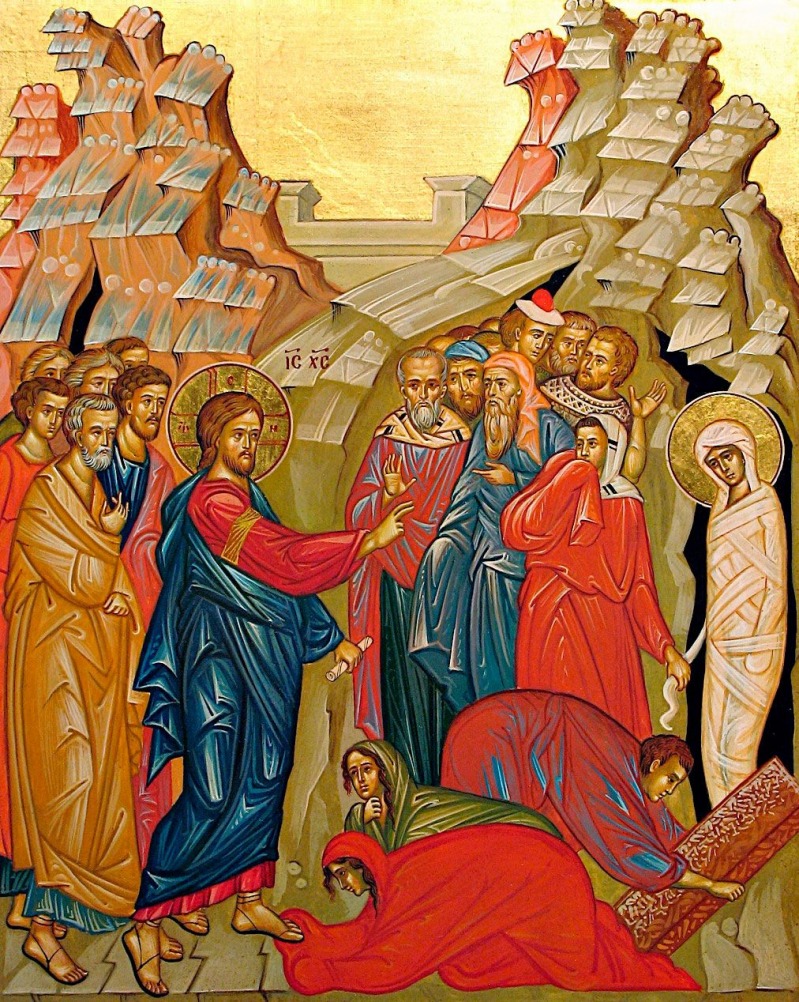
Great Lent is slowly coming to an end. However, before we enter the days of passion and mourning, the Gospel passage of the Raising of Lazarus insists on reminding us of the message of the Resurrection.
GOSPEL PASSAGE: THE STORY OF LAZARUS
According to the Gospel, Lazarus was the brother of Mary and Martha of Bethany. Jesus knew his family and had stayed with them many times during his travels. When Lazarus fell ill, his sisters asked Jesus to come to Bethany and save him. However, he waited for two days before starting the journey to the city. He told his disciples:
"This sickness will not end in death. No, it is for God's glory so that God's Son may be glorified through it."
The sickness quickly took over Lazarus and led to his death. Despite this, Christ announced the joyful event of his Raising, explaining to his disciples thus:
"Our friend Lazarus has fallen asleep; but I am going there to wake him up."
When he arrived at Bethany four days after the death and burial of Lazarus, he found Martha and Mary mourning. In fact, Martha lamented to Jesus that had he arrived earlier, he would have been able to save her brother. She believed in the resurrection of the dead at the Second Coming, though it seemed a distant and almost mythical event, compared to the silent figure of her brother. Jesus revived her faith by reminding her:
"I am the resurrection and the life. He who believes in me will live, even though he dies; and whoever lives and believes in me will never die. Do you believe this?"
Later, he went to the tomb of Lazarus. At this point, the Gospel passage reveals the mystery of the Christological doctrine. Being a perfect man, Jesus cried over the tomb of his friend. And being a perfect God, he ruled the laws of nature and ordered the resurrection of the dead shortly afterwards. He demanded the removal of the slab sealing the tomb. In obedience to His command, Lazarus rose and went out into the light. Jesus's words "Lazarus, come out!" were enough to raise him and present him alive and well before the eyes of the crowd.
After his Raising which occurred at the age of 30, Lazarus lived for another 30 years. He eventually became the bishop of Kition in Cyprus, where he was buried at the end of his life. His relics were found in 890 AD by the Byzantine emperor Leo VI the Wise, who took them to Constantinople and placed them in the homonymous church in honor of St Lazarus. The acquisition of his relics is celebrated on October 17.
ICON OF THE RISING OF LAZARUS
The icon represents the event of the Raising of Lazarus in presence of his family and the crowd. As two men are moving the grave slab, Lazarus's sisters worship Christ by kissing his feet; the disciples surrounding him are full of excitement, and Lazarus, who bends his body towards Jesus, is full of gratitude and praises the Lord. Finally, in the center of the icon there's a figure of Jesus himself, bringing Lazarus back to life by a mere blessing gesture.
In earlier depictions, Lazarus also appears as the bishop of Kition. His figure is sad and solemn. According to tradition, Lazarus remained somber for the rest of his life, retaining in his memory the images of beyond. However, bearing the stigma of death throughout his all life, he also became a proof of the undeniable victory of the resurrection of his soul and body..jpg)
THEOLOGICAL INTERPRETATION
The significance of the resurrection of Lazarus is extremely important to the doctrine of our church. Beyond the greatness of the Gospel passage, the very fact of a man raised from the dead and brought back to life, just before the Resurrection of the Lord himself, is a great mystery and miracle. According to the theological interpretations attributed to this event, his resurrection is first and foremost a precursor of the Resurrection of Christ and, by extension, of the entire human race. It is the incontrovertible proof of God's ability to exceed even the ultimate natural principle of the mortality of the humankind. The resurrection, interpreted as an abstract doctrine and an ecclesiastical law, for the first time becomes concrete. Furthermore, the resurrection of Lazarus symbolizes the spiritual resurrection that every Christian can experience many times during his life. Christ has the ability to call us back, to save us from both physical and spiritual death. Even if we reach the beyond of our spiritual decay, we can still rise and God can, with just a word, restore us to the joy of spiritual peace.
APOLYTIKION
“By raising Lazarus from the dead before Your Passion, You confirmed the universal resurrection, O Christ God! Like the children with palms of victory, we cry out to You, O Vanquisher of Death; Hosanna in the highest! Blessed is He that comes in the name of the Lord!”

